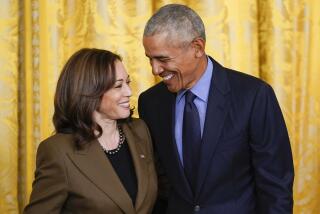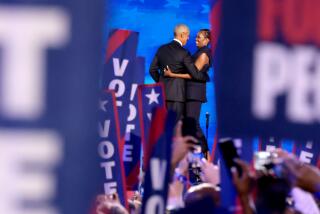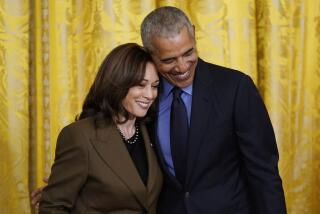Review: David Maraniss’ ‘Barack Obama’ is a biography of ambition
Barack Obama
The Story
David Maraniss
Simon & Schuster: 643 pp., $32.50
Abnormal men become presidents of the United States.
The overweening self-confidence required to reach for the office, the preternatural discipline and effort of will needed to grasp it — in another setting, these traits might be called pathological. Tracing the roots of abnormality becomes a recurring motif in presidential biographies: polio’s impact on Franklin D. Roosevelt, the death of John F. Kennedy’s eldest brother, the absent or dysfunctional fathers of Lyndon B. Johnson and Bill Clinton.
In relatively few cases, however, has biography become so central to both a president’s admirers and despisers as it has for Barack Obama. Clinton, for example, made much of his “Man from Hope” persona but mostly to counteract suspicions raised by his Ivy League law degree, his Rhodes scholarship and his well-publicized efforts to stay out of the Vietnam-era draft. His campaign biographies focused on more standard adult fare — terms as governor, education reforms, economic development.
Not so Obama. When he ran for president, the then senator from Illinois had little experience to tout. Biography formed the core of his appeal.
“I stand here knowing that my story is part of the larger American story, that I owe a debt to all of those who came before me, and that in no other country on Earth is my story even possible,” Obama proclaimed in the 2004 Democratic convention keynote address, which brought him to the attention of a national audience. Four years later, in a country strongly turning against the Texas swagger and go-it-alone hubris ofGeorge W. Bush, Obama’s multiracial parentage and cross-cultural background was powerfully appealing — the perennial hope of a chance to start anew.
The counter-narrative began in the shadows and reached full, public flower only after Obama’s election. Whether in the seemingly irrepressible theories about his birthplace or the endless speculation about the ideological legacy he might have garnered from the Kenyan father he barely ever met, Obama’s exotic parentage and unusual background stoked the anxieties of his enemies — the perennial fear of otherness and subversion.
In “Barack Obama: The Story,” David Maraniss seeks to transcend the myth-making of both sides and tackle two major issues: the legacy of family history and the values that shaped Obama and the internal forces which set him on his rapid, unlikely climb to the White House.
The legacy occupies the first third of the book as well as several subsequent chapters. Maraniss backs up to the fourth generation, giving readers a deeply researched tour that begins in colonial Kenya and 1920s Kansas. (Obama himself isn’t born until 165 pages into the text.) These chapters, particularly the detailed story of Obama’s brilliant but deeply irresponsible, alcoholic and self-destructive father, provide some of the book’s most fascinating passages. Particularly revealing is just how fleeting was the relationship between Obama’s parents — a marriage that lasted barely longer than Stanley Ann Dunham’s pregnancy — and how carefully his mother sheltered him from the harsh reality of paternal abandonment.
Yet it is the book’s other narrative — the description of the kindling of Obama’s ambition — that will almost certainly attract the greatest readership even though it is also the most elusive of the book’s themes.
Maraniss has plowed the ground of ambitious young men before. Almost two decades ago, his first book dived deeply into the early life of Bill Clinton. But the 42nd president was in some ways a less complex subject. Clinton, as Maraniss described in that volume, began running for office in grade school and kept at it so relentlessly that his high school principal barred him from running for senior class president because he was hogging the offices.
From Hot Springs, Ark., to Georgetown to Oxford to Yale Law School and beyond, Clinton never stopped running — and never took time to confront the internal demons that drove him. He arrived at the White House with the finest political skills of a generation and personal flaws capable of causing disaster.
Obama, by contrast, for all his exotic background, lived a prosaic adolescence. From age 10, when he returned from Indonesia to Hawaii to live with his grandparents, he had a life that would be hard to distinguish from that of millions of other teenage American boys — basketball playing, smart but somewhat unfocused.
From Hawaii to Occidental College the story was much the same. And when he arrived at Columbia University after two years at Occidental, the character trait that most stood out was Obama’s introversion.
By necessity, the story Maraniss tells becomes an interior one. Obama related his version of that interior journey in his memoir, “Dreams From My Father.” But, as with many memoirs, Obama’s was a work of imagination — not fiction but a deeply subjective telling.
Maraniss supplements and corrects Obama’s account at several key points. As he does, we begin to see many of the traits that would come to mark Obama as president — the aloofness, the desire to avoid traps, the dislike of confrontation, the belief in his ability to persuade adversaries to see things his way.
For several formative years, Obama approached life as his mother, the anthropologist, was trained to do: as a participant observer. He watched, he studied and — in sharp contrast to Clinton — he learned about himself. In those New York years, Maraniss writes, Obama was “conducting an intense debate with himself over his past, present, and future, an internal struggle that he shared with only a few close friends.”
Luckily for the biographer and the reader, Maraniss located three of those friends — two former girlfriends and a roommate — who were not only perceptive and kept letters and a diary but were willing to allow him to use that material in his book. Maraniss’ footnotes contain the names of 230 individuals he interviewed and 18 library archives he mined on three continents, but without those three, the story of Obama in New York — a tale with so much of the action taking place inside the subject’s mind — would have been all but impossible to tell.
It was in this period, 1981-85, in his early 20s, that Obama appears to have developed the belief that he could take a leadership role in society and that doing so would require him to become more than an observer. And yet, readers in search of an “aha” moment will come away disappointed. In this volume, at least — Maraniss already has begun work on the next — there is no single spark, no switch that suddenly turned on Obama’s driving ambition. Instead, a more useful metaphor might be the tumblers of a lock falling into place, one by one.
As the book closes, Obama is headed for law school. After years of interior monologue, he was about to discover his public voice.
More to Read
The biggest entertainment stories
Get our big stories about Hollywood, film, television, music, arts, culture and more right in your inbox as soon as they publish.
You may occasionally receive promotional content from the Los Angeles Times.











